

Bonsai-making is definitely an art that deserved discovering. The Ficus bonsai is a great plant to start off with. But which type is best for you?
Ficus bonsai facts
Name – Ficus species
Family – Moraceae (mulberry family)
Type – easy bonsai, indoor plant
Height – 8 to 32 inches (20 to 80 cm)
Soil – bonsai plant mix, well drained
Exposure: lots of indirect light – Foliage: evergreen – Watering: moderate
Care is threefold: water when dry, repot every 2-3 years, and prune often.
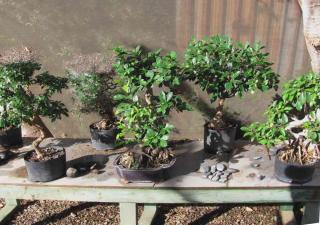 Watering is essential. The key is to only water when the soil is dry. That way, you’re sure to avoid root rot.
Watering is essential. The key is to only water when the soil is dry. That way, you’re sure to avoid root rot.
In winter your bonsai will need much less water, perhaps only once a fortnight. In summer, however, it gets thirstier: you might have to water twice a week.
The most important care you can give your bonsai ficus is to repot it when needed. Every two or three years, repot your ficus bonsai to give it fresh soil nutrients and aerate/thin the root clump.
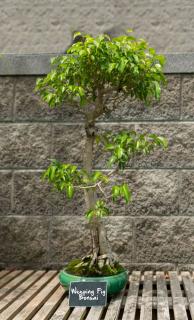 Trimming off long shoots is the way to keep your ficus bonsai in shape. Every time you cut the tip off a branch, at least two new branches will sprout out from below. A good rule of thumb to prune well is to snip the tip off every time a branch has 5 or 6 leaves already.
Trimming off long shoots is the way to keep your ficus bonsai in shape. Every time you cut the tip off a branch, at least two new branches will sprout out from below. A good rule of thumb to prune well is to snip the tip off every time a branch has 5 or 6 leaves already.
The bonsai shown here is trimmed according to an ancient Japanese pruning technique called ‘Niwaki‘, or cloud pruning.
Apart from thrips and, occasionally, scale insects, you won’t ever get any pests on your bonsai ficus.
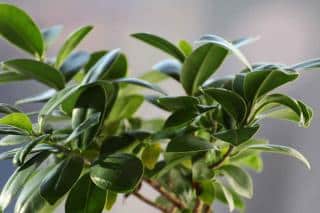 The most common ficus bonsai is, without a doubt, Ficus ginseng. The lush, thick roots are fascinating to look at! Usually, ficus ginseng are grafted. You can tell because there’s a small stump with new branches growing out of it.
The most common ficus bonsai is, without a doubt, Ficus ginseng. The lush, thick roots are fascinating to look at! Usually, ficus ginseng are grafted. You can tell because there’s a small stump with new branches growing out of it.
It’s an easy bonsai to care for since it doesn’t die very easily.
Apart from this perfect beginner bonsai, it’s also possible to grow ficus bonsai from other species as well:
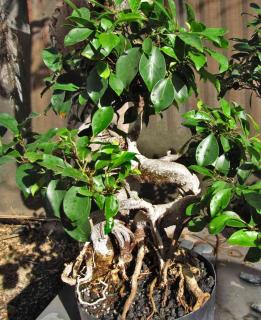 The “small-fruited fig” has roots that swell at the crown. Nurseries uproot them a bit and plant them higher up to showcase these thick roots.
The “small-fruited fig” has roots that swell at the crown. Nurseries uproot them a bit and plant them higher up to showcase these thick roots.
Beautiful bark on all varieties. In time, the whole bonsai takes on a convoluted, attractive look, especially when air roots start forming.
Quite a few varieties are available:
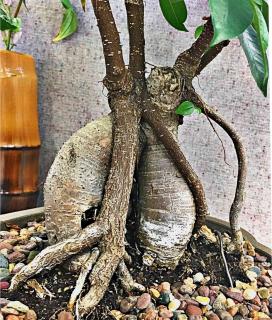 Ficus retusa is often selected to grow mid-sized bonsai. In hotels and lobbies, this is the variety you’ll find.
Ficus retusa is often selected to grow mid-sized bonsai. In hotels and lobbies, this is the variety you’ll find.
It grows trunks that can be easily shaped.
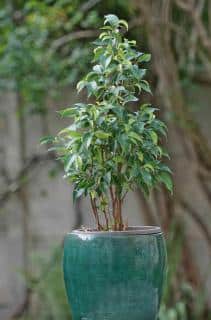 The slightly larger leaves of Ficus benjamina mean that this variety is also best for larger bonsai. In the wild it can grow dozens of feet high (several meters).
The slightly larger leaves of Ficus benjamina mean that this variety is also best for larger bonsai. In the wild it can grow dozens of feet high (several meters).
In particular, this species is great to experiment with braiding trunks. Braided ficus trunks definitely have a surprising appeal!
Rare and elegant is the Ficus benjamina ‘Nastaja’ (shown here): a bundle of trunks is wrapped in burlap, and it grows into a beautiful small-leaved weeping fig bonsai. Watch out because it doesn’t like staying dry for too long.
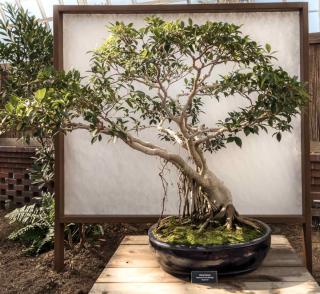 There are hundreds of ficus species and almost all of them can be grown as bonsai. Shown here is a 40 year-old Ficus thonningii.
There are hundreds of ficus species and almost all of them can be grown as bonsai. Shown here is a 40 year-old Ficus thonningii.
It’s extremely rare to see any fruit on a ficus bonsai, but it can happen. The Ficus microcarpa is known to have tiny fruits like figs, no bigger than a fingernail. They’re rarely fertile, though, since each species depends on a single specific wasp species for pollination.
There are three ways to thicken the trunks of a ficus bonsai and make it more interesting.
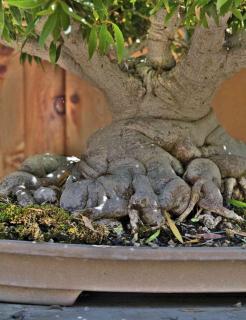 The typical way of thickening a ficus bonsai stem is to let it grow larger. The more leaves and large branches it has, the more wood appears around the trunk to feed them. After you’ve reached your target trunk size, cut the branch back to the trunk. Prune any new twigs short to keep the bonsai shape.
The typical way of thickening a ficus bonsai stem is to let it grow larger. The more leaves and large branches it has, the more wood appears around the trunk to feed them. After you’ve reached your target trunk size, cut the branch back to the trunk. Prune any new twigs short to keep the bonsai shape.